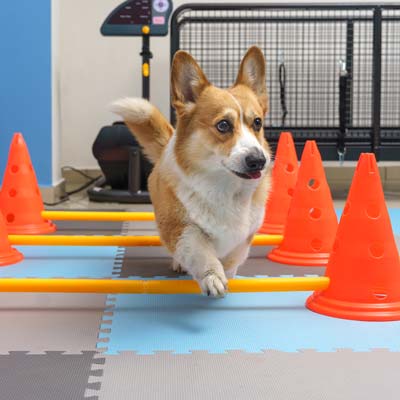Last Updated on 2 years by Dr Alisha Barnes

Just like us, our dogs need exercise each day. Depending on your dog’s lifestyle, they may need more or less exercise based on how active they are on a regular basis. The size of your dog is also an important determining factor about how much exercise they need—the larger your pup, the more likely that they would benefit from a longer duration of exercise. If you’ve been wondering just “how much exercise does my dog need every day?” you’ve come to the right place. Read on to learn more!
How can a pet chiropractor help my senior dog?
The main goal of chiropractic care for senior dogs is to reduce pain and improve their quality of life. Many pet owners don’t realize that their older dogs may be in pain. Just like humans, as our dogs age, they can experience joint stiffness and degenerative changes that lead to pain.
A pet chiropractor will conduct a thorough examination to determine where in the body there may be misalignment, imbalance, degeneration, or pain. Your pet chiropractor’s goal is to provide gentle treatment that helps to move bones and ligaments into the most comfortable place possible in the body. This can help to alleviate nerve pain, back pain, muscle pain, mental fog and disorientation, and a variety of other symptoms that are common in senior dogs.
Chiropractic care has many benefits for dogs, both young and old. For senior dogs, chiropractic care can help to reduce pain and improve their quality of life. It can also help to improve mobility and flexibility, which can be especially helpful for older dogs who have a harder time getting around. Additionally, chiropractic care can help to improve mental clarity and focus, which can be beneficial for senior dogs who may be experiencing some cognitive decline.
Small Dogs (Under 30 pounds)
If you have a small dog that weighs under 30 pounds—for example, a pomeranian, chihuahua, Maltese, Shih Tzu, Pug, Terrier, Bichon Frise, Cavalier King Charles, or another type of small dog (including a mix), your dog will thrive on about 30 minutes of exercise a day.
Smaller dogs are generally thought of as requiring less exercise because they typically get a lot of it just by existing! In a small dog’s world, there is a lot of ground to cover, even in a small home. This also often includes jumping on and off of furniture, which is a form of exercise in and of itself.
Even though small dogs receive a lot of exercise just by making their way around their environment, they will benefit from 30 minutes of devoted exercise a day, even if it’s split into multiple sessions. This could look like three 10-minute sessions or two fifteen-minute sessions. The purpose of this exercise is to help build your furry friend’s endurance, keep their muscles warm, flexible, and limber, and help oxygenate their bodies. For small dogs that have flat noses (breeds include Pugs, Boston Terriers, French Bulldogs, and Shih Tzus), dividing exercise time over the course of the day can help manage their ability to breathe effectively during activity.
Medium Dogs (Between 30 and 55 pounds)
If you have a medium dog, which includes Shepherds, Cocker Spaniels, Bulldogs, Golden Retrievers, Boxers, Collies, Labradors, Poodles, Sheepdogs, and mixes, then you will want to commit to exercising your medium-sized dog for at least 60 minutes a day.
As dog breeds increase in size, the activity required to strengthen and preserve their muscle tone and strength, as well as their bone structure, also increases. Medium-sized dogs thrive in activities like walking, running (dependant on weight and breed), and swimming (with a life jacket and proper supervision).
Large Dogs (55+ pounds)
If you own a large dog breed, for example, a St. Bernard, Mountain Dog, Great Dane, Newfoundland, Malamute, Greyhound, Mastiff, mix, or any breed that naturally weighs over 55+ pounds in adulthood, your dog needs at least two hours of exercise a day.
Because of the size of a large dog’s body, their muscles, joints, cardiovascular system, respiratory system, and nervous system require more exercise to keep their health at its peak than their smaller-sized fellow dogs. This means that if you have a large dog breed, it’s critical to provide at least two hours of walking, running (with appropriate rest periods), and swimming (with a life vest and supervision) for your dog.
Things to Consider
When it comes to exercise for your furry friend, be sure to consider their age, their overall health, their breed and anatomy, and any pre-existing health conditions they may have.
Age
When your dog is young—under the age of one year old—it’s important not to over-exercise them. It’s important not to make your dog your running buddy (especially if they a large breed). Too much exercise too early in a dog’s life can actually contribute to damage in your dog’s body, putting strain on their developing cartilage, as well as their muscles and joints. Let your puppy guide the playtime, and when they begin to show signs of tiredness, allow them to wind down.
Breed
Breed is another important consideration, as it dictates your dog’s size. The larger the dog, the more exercise is required (after the first year of life).
Anatomy
Your dog’s anatomy is an important factor to consider when taking their exercise needs into account. Some breeds, for instance, those that are brachycephalic (flat and wide-nosed), may require exercise in short spurts, rather than for long durations of time, to ensure they are able to breathe sufficiently.
Health Conditions
It’s always important to understand any health conditions or genetic predispositions your furry friend may have. Some breeds are prone to weaknesses in their joints, ligaments, and skeletal structure, which may require you to pay special attention when exercising your dog.
Care for All Breeds
If you’re looking for wellness support for your dog, look no further than Tails Chiropractic Care. Offering the most comprehensive pet chiropractic care available for your dog’s joints, ligaments, bones, muscles, and nervous system. If you’re interested in supporting your dog’s wellness and ability to exercise safely and healthfully, book your appointment today. Tails Chiropractic Care serves the Boulder, Windsor, Fort Collins, and Broomfield areas.
